Japanese tea owes its green color to the lack of fermentation. While steamed teas are far more common, there is another kind of unfermented tea that has a stronger aroma: pan-fried tea, or kamairicha. The second installation of a two-part series, this article discusses the tea varieties grown in Japan and takes readers to another small village where residents privately produce kamairicha.
Zairai and Yabukita: The Future of Pan-Fired Tea
The word zairai is ordinarily used to describe varieties of vegetables and plants that are native to a particular region. When it comes to tea, however, it refers to heirloom trees of unknown variety.
National and prefectural research institutions have long engaged in tea cultivar improvement with a focus on the processing characteristics, earliness, regional characteristics, productivity, and resistance to disease and insects. Following the end of World War II, the national and prefectural governments began promoting the replacement of zairai trees with cultivar trees in tea farms.
There are broadly three groups of tea cultivars currently registered in Japan: those registered by the Ministry of Agriculture, Forestry, and Fisheries (54 varieties), those registered under the Plant Variety Protection and Seed Act (51 varieties) 1 , and those that have been developed in specific prefectures. But the truth is that Japanese teas have become highly uniform in terms of the varieties used. Whereas only 3.4 percent of tea trees in tea farms were cultivars as of 1954, indicating that most tea farms solely consisted of zairai trees, in half a century that figure had risen to a good 92.1 percent (as of 2004). Furthermore, in 82 percent of tea farms growing cultivars, which in themselves account for over 90 percent of tea farms nationwide, the trees were of the Yabukita variety.
Local governments including Shizuoka Prefecture have come to view the ubiquity of Yabukita with concern. Shizuoka has noted that the uniformity of the Japanese tea currently being produced is "discrepant with diversifying consumer needs" and "allowing inroads into the Japanese tea consumer base by other beverages and by imported teas." 2
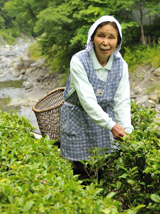
As the same document states, "Given the present demand for environment-friendly tea cultivation, varieties with low fertilizer requirements and those with disease and insect resistance are to be desired." Under the current dominance of the Yabukita variety, the picking period is highly concentrated for steamed tea production, and overemphasis on umami (savor) makes heavy use of nitrogen chemical fertilizers the norm. The soil needs to be fed with large amounts of nitrogenous components to add the savor of amino acid to the tea trees. This is a potential environmental issue, as excessive use of nitrogen fertilizers leads to contamination of rivers and groundwater.
Prefectures give application standards of between 50 and 70 kilograms of nitrogen components per 10 ares. But these figures are two to three times those for citruses, which are also evergreen trees. Moreover, too much nitrogen exhausts the trees and increases their susceptibility to disease, generating a vicious cycle whereby pesticides must be heavily used to keep the nitrogen-overdosed trees going.
A Golden Opportunity for Pan-Fired Tea
Pan firing is a largely manual process, meaning that production is only done on a small scale. But thanks also to the technique of wilting, the characteristic aroma of tea is strongly present in the finished product.
It has been pointed out that there is hardly any need to use pesticides and chemical fertilizers if different varieties are grown so as to stagger the harvest and if producers seek aroma rather than savor. In fact, excessive application of chemical fertilizers is said to kill the delicate aroma of tea, and some people also insist that it leaves an unpleasant aftertaste. Funamoto uses chemical fertilizers only sparingly and has not had to use pesticides for the past decade.
During our visit, Matsumoto served everyone his own tea in Funamoto's living room. Made with zairai tea leaves, it was the product of his many trials with the wilting time and final firing. Matsumoto continues to study and experiment with kamairicha , pinning his dreams on the future of the tea.
"In the age to come, I think people who have tea like this, with character and individuality, will have an edge," says Matsumoto. "The other teas are all Yabukita, and what with production being mechanized in big factories, they're are all the same stuff. Teas with character are what are needed now." Now is the chance, he believes.
Shigeo Funamoto has made history in the mountains of Kyushu by producing "tea for drinking." The younger Kazuya Matsumoto aspires to open up the future of kamairicha while learning from the other, a veteran in the art. The humble hopes of two men of two different generations who share a passion for tea shone small but brilliant in the little mountain village.
Everyday Tea in a Village of Slash-and-Burn Farming
Shiibason is the quintessential mountain village. With a population of 3,500, it is located near the northwestern border of Miyazaki Prefecture, not far from Izumimachi in Kumamoto Prefecture. It is a place thick with history, from a ritual song and dance known as Shiiba Kagura that has been handed down mostly unchanged for several hundred years to local everyday traditions that have been observed from days of old. Slash-and-burn farming is still practiced here.
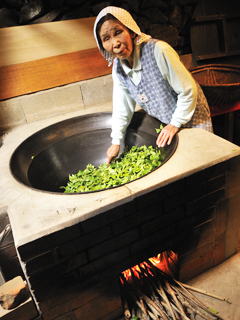
We visited 78-year-old Fujiko Shiiba, who makes kamairicha in this village, though only for private consumption. She lives by a small stream that flows into Lake Shiiba. She grows tea in a small 5-are field, reclaimed from steep woods along the stream and walled on both sides by mountains. With the tea grown here, She produces kamairicha for herself and her family, as well as to share with relatives and close friends.
"Every family in this village has a tea field in the mountains, and picking tea leaves has always been the women's job. In my family, my father used to knead the leaves that the women picked during the day. My father, he would go out to work in the woods in the daytime, while the women were kept busy picking more leaves."
It was once a family affair in Fujiko Shiiba's house to make a year's worth of tea in the May tea season. But this tradition has eroded nowadays, and the younger men do not know how to make tea. Still, it is taken for granted in Shiibason that families produce their own tea.
In the mornings and evenings, after the bustle of tending the children and men has settled, it is not teatime but time for "tea work" for the women of the village. The women must play double or triple roles during tea season.
"That's why it's hard," explains Shiiba's daughter. "In houses where no family members can help out, they can't make tea anymore even though they have tea plants in the mountains and firing pans at home. As for us, we're still able to make our own tea thanks to our mother, who's hanging in there. With tea, if nothing else, we would prefer to stick to the homemade stuff."
The Shallow Pan: An All-Rounder
After our initial chat over tea, Shiiba led us to the doma --an earth-floored area in traditional Japanese houses that typically doubles as the kitchen and entryway. Although it was past picking season, she had kindly picked some tea leaves early in the morning so that she could demonstrate roasting the leaves.
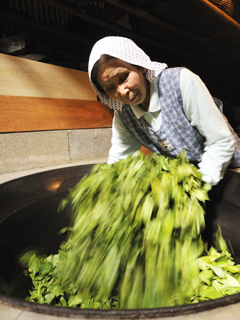
In the middle of a small doma about the size of six tatami mats, a shallow pan measuring about 90 centimeters across sits gleaming black on a concrete pedestal. The large stove appears to be of the cooking kind rather than one especially made for roasting tea, like what I had seen in Izumimachi. Once the stove is fired up with wood and the camera is set, Shiiba gets going.
The tea leaves glow under the shaft of light falling from a small skylight into the dim room. Shiiba deftly stirs the fresh leaves with a handcrafted oak mixing stick held in her right hand. The air is filled with the snapping sound of roasting leaves and steam rising from them as they give off their moisture. Smoke rises too; the heat does not stay even, perhaps because of our unskilled hands trying to help with the fire. The photographer keeps shooting with teary eyes, however, in an effort to respond to Shiiba's generosity.
Being off-season, the leaves are tough and take longer than usual to roast.
"That should do," Shiiba remarks some 20 minutes later. Taking the leaves over to a domestic kneading machine with a capacity of only about 3.4 kilograms, she turns on the switch.
Hand-picked, hand-roasted tea is finished by repeating this process. Shallow pans of this type can be found in most village homes, but due to the decline in families that make their own tea, few use the pans for roasting tea.
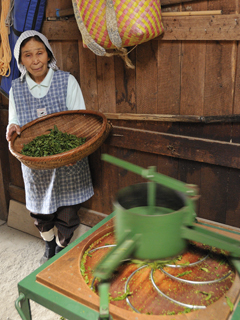
"The way we work during the tea season is, we pick the leaves in the daytime and spread them out in the shed. Back when we didn't have electricity, we couldn't work at night. The idea was that we should get on to bed once it was dark, so as not to waste firewood. Every family would pick the leaves by day and make them into tea the next morning. We would pan-fire the previous day's harvest at five in the morning, and that was our routine every day. When you let the leaves sit overnight, they wither nicely and become easier to roast."
It occurred to me that allowing the leaves to sit in a shed overnight before pan-firing them the following morning sounded just like the wilting process that Funamoto of Izumimachi uses to draw out the aroma. Shiiba's family had practiced this simply as a matter of course, oblivious to what they were actually doing. Similarly, the pioneers of pan-fired tea in fourteenth-century China may have been led to aromatic tea through procedures initially designed out of practical considerations. As I thought these thoughts, the crisp aroma of freshly roasted tea saturated the room.
A Culture of Reciprocity
The Shiiba family makes daily use of tea bags--not prepackaged tea, of course, but small disposable bags (about 4 centimeters by 5 centimeters) made of nonwoven fabric. A bag stuffed with homemade tea leaves is put into a large kettle to brew plenty of tea, which is then transferred into plastic bottles for each family member to take to work or to school.
Everyone in Shiibason carries their own tea, we were told. The villagers have an intimate relationship with tea. The idea of buying tea seems foreign to these people.
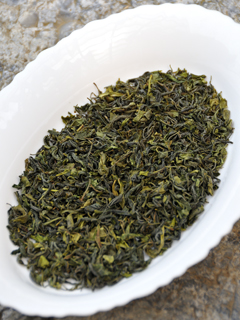
"Homemade tea is our pride, and we consider it a great gift to give to people. Others here feel the same way about their tea. Many people who can't pan-fire the tea themselves still pick their own tea leaves and have them roasted at a nearby tea factory."
It is customary for residents of Shiibason to give their tea to friends and relatives. For them, self-sufficiency and reciprocity are the norm when it comes to tea.
Fujiko Shiiba taught us the local word kacha-ari . Meaning "to help one another" or "to back up one another," it refers to a village custom similar to the idea of yui seen elsewhere: cooperating with one another when group labor is needed, such as when planting rice or rethatching homes. Evidently, homemade tea has served as a vehicle for keeping alive the tradition of hospitality in Shiibason.
Photos: Kazuo Kikuchi
1 Japanese Tea Central Association, Heisei 19-nendo cha kankei shiryo (Fiscal 2007 Data on Tea).
2 Shizuoka Prefecture, Shizuoka-ken chagyo shinko kihon keikaku (Heisei 13 nendo-17 nendo) (Basic Plan for Promotion of the Shizuoka Prefecture Tea Industry, Fiscal 2001-Fiscal 2005).
